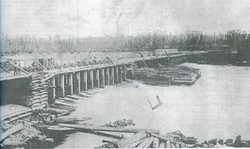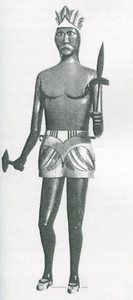Little Falls Dam

The NSP dam at Holcombe, Wisconsin is actually the third dam to be constructed along this stretch of the Chippewa River. The original dam, which spanned the river less than one mile north of the present structure, was called the Little Falls Dam.
Built in 1872 by the Union Lumbering Company, both the dam and community were then known as Little Falls. For timber crib construction, the dam was reputed to be the world's largest "right angle" wooden dam. Its purpose was to store water that could later be released to float logs down river. In the late 1800s, the virgin timber in the country to the north attracted a growing lumber industry. Floods were still common events on the Chippewa River and portions of the wooden dam frequently floated away in times of high water. In 1885 a flood tore the dam out entirely. It was immediately rebuilt, however, to meet the needs of the Chippewa Lumber and Board Company, which had acquired the dam in 1880. Operating the world's largest sawmill down river in Chippewa Falls, the company built the world's largest wooden dam to supply the logs. While the dam brought prosperity to the area, it also witnessed tragedy. A terrible accident occurred at the dam in 1905 when a river boat capsized and eleven young men, who were taking part in the annual log drive, drowned.
By 1910 the logging boom was over and the big mill closed its doors. Although the sawmill had endured floods and fires, survived market crashes, and driven out its competitors; it finally failed when the supply of logs were gone. That year the dam at Little Falls was also abandoned.
In 1912 the site was purchased by the Chippewa Valley Construction Company, which sold the dam in 1914 to the Wisconsin-Minnesota Light and Power Company (later Northern States Power Company). Damaged by the river, the rest of the Little Falls Dam washed away sometime in the 1920s. It wasn't until 1950, when the present dam was completed, that the river's power at Holcombe was again harnessed. This time to light the buildings constructed of the logs once collected behind the old wooden dam.
Originally called Little Falls in the 1870s, the community was established by the Union Lumbering Company along the Chippewa River and came to be known as Holcombe years later.The original Little Falls dam was built in 1878 by Elijah Swift and Joseph Viles for the Chippewa River Improvement and Log Driving Company. It was big for the time, a wooden dam 625 feet wide and 16 feet high with 32 floodgates. Its main aim was to provide reliable water for floating logs downstream, even when natural water levels were low. With its gates wide open, it could raise the Chippewa 3 feet and raise waters 100 miles downstream. Parts of the dam were washed out by floods in 1880 and 1884. After the second washout, a dam-building specialist named Billy "the Beaver" England was brought in. He and his crew rebuilt the dam in the winter of 1884-1885 and it survived the floods for many years after. The journal of the dam's keeper from 1882 to 1890 still survives, briefly describing log drives, jams, and the flood of 1884. A terrible accident occurred in 1905, when eleven log drivers drowned trying to get to a log jam near the dam. The dam functioned until 1910, when logging operations ceased. It washed out in the 1920s. The current hydro-electric dam was built in 1950 by the Wisconsin-Minnesota Light and Power Company, producing the current Holcombe Flowage. The flowage is a popular recreation area, and the shores are thick with homes and cottages.
Built in 1872 by the Union Lumbering Company, both the dam and community were then known as Little Falls. For timber crib construction, the dam was reputed to be the world's largest "right angle" wooden dam. Its purpose was to store water that could later be released to float logs down river. In the late 1800s, the virgin timber in the country to the north attracted a growing lumber industry. Floods were still common events on the Chippewa River and portions of the wooden dam frequently floated away in times of high water. In 1885 a flood tore the dam out entirely. It was immediately rebuilt, however, to meet the needs of the Chippewa Lumber and Board Company, which had acquired the dam in 1880. Operating the world's largest sawmill down river in Chippewa Falls, the company built the world's largest wooden dam to supply the logs. While the dam brought prosperity to the area, it also witnessed tragedy. A terrible accident occurred at the dam in 1905 when a river boat capsized and eleven young men, who were taking part in the annual log drive, drowned.
By 1910 the logging boom was over and the big mill closed its doors. Although the sawmill had endured floods and fires, survived market crashes, and driven out its competitors; it finally failed when the supply of logs were gone. That year the dam at Little Falls was also abandoned.
In 1912 the site was purchased by the Chippewa Valley Construction Company, which sold the dam in 1914 to the Wisconsin-Minnesota Light and Power Company (later Northern States Power Company). Damaged by the river, the rest of the Little Falls Dam washed away sometime in the 1920s. It wasn't until 1950, when the present dam was completed, that the river's power at Holcombe was again harnessed. This time to light the buildings constructed of the logs once collected behind the old wooden dam.
Originally called Little Falls in the 1870s, the community was established by the Union Lumbering Company along the Chippewa River and came to be known as Holcombe years later.The original Little Falls dam was built in 1878 by Elijah Swift and Joseph Viles for the Chippewa River Improvement and Log Driving Company. It was big for the time, a wooden dam 625 feet wide and 16 feet high with 32 floodgates. Its main aim was to provide reliable water for floating logs downstream, even when natural water levels were low. With its gates wide open, it could raise the Chippewa 3 feet and raise waters 100 miles downstream. Parts of the dam were washed out by floods in 1880 and 1884. After the second washout, a dam-building specialist named Billy "the Beaver" England was brought in. He and his crew rebuilt the dam in the winter of 1884-1885 and it survived the floods for many years after. The journal of the dam's keeper from 1882 to 1890 still survives, briefly describing log drives, jams, and the flood of 1884. A terrible accident occurred in 1905, when eleven log drivers drowned trying to get to a log jam near the dam. The dam functioned until 1910, when logging operations ceased. It washed out in the 1920s. The current hydro-electric dam was built in 1950 by the Wisconsin-Minnesota Light and Power Company, producing the current Holcombe Flowage. The flowage is a popular recreation area, and the shores are thick with homes and cottages.
To read more History of The Jewel of the North Holcombe, click HERE
Holcombe Indian

The Holcombe Indian was known to river men along the Chippewa since 1876. He was called the King of the Chippewa River. This wooden statue stood guard on the Old Holcombe (Little Falls) Dam and was a most welcome site to lumberjacks driving their logs down the river to be sawed into lumber at the local mill, or held and sliced through the log-way in the dam to be cut at the big mills at Chippewa Falls or Eau Claire.
The Indian brave was created by Luke Lyons using an axe, drawshave and a pocket knife. Lyons, a former sailor, was a straw boss employed by the Chippewa Lumber and Boom Company. He carved the Indian straight, impressive, and nearly eight feet tall from a carefully selected white pine log cut by Jene Juvette near Pine Lake, just north of Holcombe. During a flood in 1881, the Holcombe Indian was dislodged from his place on the dam and over the falls and rapids he went, down the river all the way to Jim Falls where he was rescued. He was repaired and returned to the Holcombe Dam site where he remained until the dam was abandoned and a new modern hydroelectric power plant was built.
As a symbol through the years, the brave has been the guardian spirit of loggers and of the mighty Chippewa River. Come see the Holcombe Indian at the Holcombe Town Hall Park in Holcombe.
The Indian brave was created by Luke Lyons using an axe, drawshave and a pocket knife. Lyons, a former sailor, was a straw boss employed by the Chippewa Lumber and Boom Company. He carved the Indian straight, impressive, and nearly eight feet tall from a carefully selected white pine log cut by Jene Juvette near Pine Lake, just north of Holcombe. During a flood in 1881, the Holcombe Indian was dislodged from his place on the dam and over the falls and rapids he went, down the river all the way to Jim Falls where he was rescued. He was repaired and returned to the Holcombe Dam site where he remained until the dam was abandoned and a new modern hydroelectric power plant was built.
As a symbol through the years, the brave has been the guardian spirit of loggers and of the mighty Chippewa River. Come see the Holcombe Indian at the Holcombe Town Hall Park in Holcombe.
